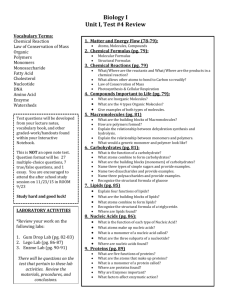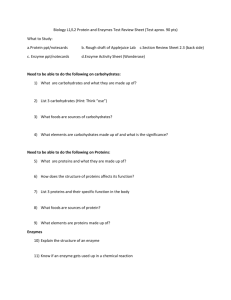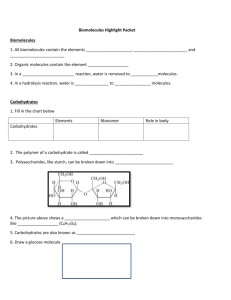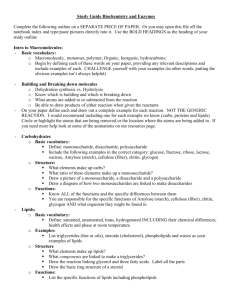Organic Molecules
advertisement
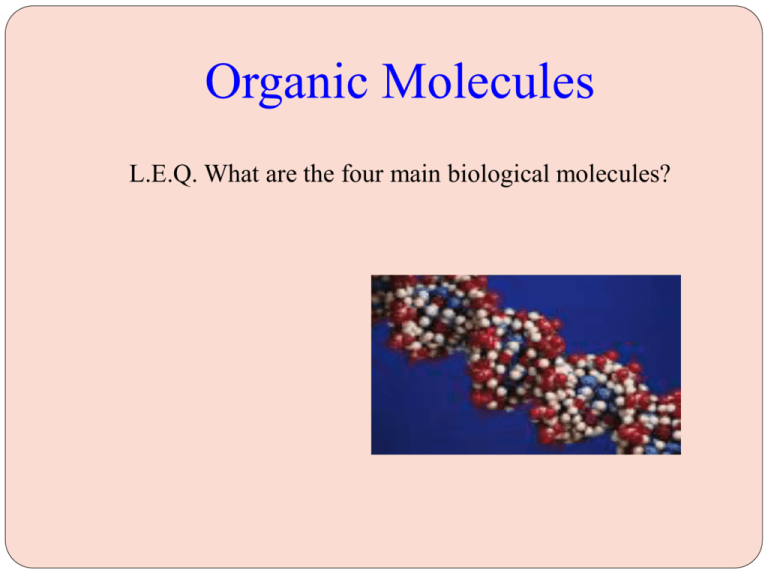
Organic Molecules L.E.Q. What are the four main biological molecules? The Chemistry of Living Things Organic compounds – contain Carbon And Hydrogen Inorganic compounds – do not Carbon is an ideal Building Block Carbon is able to bond to itself and other elements to form large molecules. Organic molecules are usually large. How are they made? Monomer – a small, repeating unit (molecule) Polymer – many monomers bonded together. Macromolecule. A large molecule How do Monomers form Polymers? Dehydration Synthesis Dehydration means to take water out When monomers bond together they lose a water molecule The purple dots represent Carbon atoms https://www.youtube.com/watch?v=PYH63o10iTE time 4:14 Since many organic molecules have the elements oxygen and hydrogen in them, this isn’t hard to do. The 4 Types of Biological (Organic) Molecules Carbohydrates Lipids Nucleic Acids Proteins Carbohydrates Structure (contain what elements?) C, H, and O They are found in a ratio of 1C : 2H : 1O Monomer of Carbohydrates (or the Building Blocks) Monosaccharide Single sugars (one molecule) Examples are glucose and fructose (C6H12O6) glucose Found in plants and animals Fruit sugar found in many plants HONORS Carbohydrates - Disaccharides Double Sugar Made of two monosaccharides Most common disaccharide is sucrose (glucose+fructose) Found in plant sap We use it to make table sugar Lactose is the sugar present in milk. Carbohydrates- What is their Function? Primary Energy Source Glucose is a simple sugar that our body uses as its main source of fuel Carbohydrates- What is their Function? Storage of Energy Carbohydrates can also be stored away for later use. Examples Starch o Plants store food in the form of starch Carbohydrates- What is their Function? Storage of Energy Another Example Glycogen o Humans store glycogen in their liver. o This can be converted to energy when needed Carbohydrates- What is their Function? Structural – serves as building material in plants and other organisms. - many monosaccharide's bonded together – a polysaccharide EXAMPLES Cellulose building material of plant cell walls Chitin Forms cell walls in fungi (mushrooms) and the exoskeleton of arthropods Lipids There are many Hydrocarbons C-C-C-C-C- Carbons with hydrogen bonded to them Structure They are not made up of monomers they are simply one monomer Lipids Many Lipids are NOT soluble in water. Meaning – they do not dissolve in water They are non-polar molecules. • Remember water is polar, so other polar molecules will dissolve in water Oil and water don’t mix Groups of Lipids – Fats Saturated Lipids: every carbon atom contains the most # of hydrogens that it can. Contained in animal products. Solid at room temp. Unsaturated Lipids: there is at least 1 double bond bet. carbon atoms. Plant oils. Liquid at room temp. FYI – Trans Fats Function of Fats Energy reserves carbohydrates give short term energy storage (carbs can be turned into fats) Lipids give LONG term energy storage Protective cushion and insulator Source of energy in hibernating animals Lipids - Phospholipids Function as parts of cell membranes form the bilayer that make up cell membranes. Serves as a boundary between the cell and the environment Are soluble in water Lipids - Steroids Include Cholesterol and Sex Hormones Cholesterol is a component of cell membranes and helps keep them fluid Sex hormones include testosterone and estrogen Nucleic Acid –Structure Made up of Nucleotides These monomers are repeated many times Each Nucleotide consists of 5-Carbon sugar Phosphate Group Nitrogen containing Base Contains C, H, N, O and Phosphorus Nucleic Acids- Function Carries Genetic information Examples are DNA (deoxyribonucleic acid) and RNA (ribonucleic acid) Proteins Proteins are instrumental in almost everything organisms do! (in Greek protein means “first place”) Also called polypeptides Protein - Structure Monomers (Building Blocks) Amino Acids Consists of C, H, O, and N Many amino acids are folded into a unique 3 dimensional shape. Protein Structure honors a) Primary – the sequence of the amino acids b) Secondary- the forming of hydrogen bonds c) Tertiary – the three dimensional structure d) Quaternary – three dimensional structure when the protein has multiple units Protein - Functions Structural proteins – for support Making webs. Keratin is the protein of hair, horns and feathers Storage proteins Egg white is the amino acid source for the developing embryo Plants have storage proteins in their seeds Transport Proteins Hemoglobin, transports oxygen in the blood. Hormonal proteins Insulin helps regulate the concentration of sugar in the blood Defensive proteins Antibodies combat bacteria and viruses Enzymatic Proteins are probably the most important type of protein Enzymes regulate metabolism by speeding up chemical reactions. Protein -Function ENZYMES proteins that act as catalysts to speed up chemical reactions Catalyst – a substance that enables a chemical reaction to proceed at a usually faster rate. The enzyme is not consumed in the reaction and can be used over and over. Chemical Reactions If enzymes speed up chemical reactions, lets review what a chemical reaction is. Chemical Reaction - a process that changes, or transforms, one set of chemicals into another. Chemical Reactions are going on in your body all the time. Parts of a Chemical Reaction Reactants The elements or compounds that enter into a chemical reaction C6H12O6 + 6O2 6CO2 + 6H2O + useable energy Glucose and Oxygen are the reactants Parts of a Chemical Reaction Products The elements or compounds produced by a chemical reaction. The arrow stands for produce C6H12O6 + 6O2 6CO2 + 6H2O + useable energy Carbon dioxide, water, and energy are the products Types of Reactions Physical Reaction A physical reaction does not produce a new substance. The substance just changes its state, like solid to liquid. May change its size or shape Example: Ice melting Chemical Reaction A chemical reaction produces a new substance. Something that wasn’t there before. Clues a chemical reaction took place. Heat, light, colors, gas, and smells can be produced. Examples: Cooking, burning Protein - Enzymes How Enzymes Function Substrate – the “reactants” . These bind to the enzyme Active Site – where the “reactants” bind to the enzyme Products – what is formed during the reaction There are many different enzymes, but each one will only fit one substrate. Like a lock and key. The enzyme speeds up the reaction and forms the Products. Protein – Enzyme Functions Enzymes require specific conditions to function normally Factors that affect enzyme function Heat pH If it gets too hot, or the pH changes, then the structure of the enzyme is affected and the reaction can’t take place. The enzyme is Denatured Examples of Enzymes Enzyme names usually end in ase Lactase is an enzyme found in the intestine and helps break down lactose (a milk sugar) into other simple sugars. What happens if you lack this enzyme? Lactose will travel to the large intestine and produce gas (which can be very uncomfortable) Catalase is an enzyme found in red blood cells. It breaks down hydrogen peroxide into water and oxygen. Too much hydrogen peroxide is toxic and people who cannot break it down can develop infections. It can also lead to cancer. Monomers of Organic Molecules Organic Molecule Monomer Carbohydrate Monosaccharide Nucleic Acid Nucleotide Protein Amino acid



